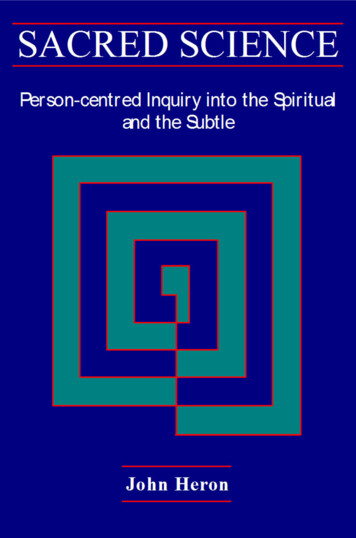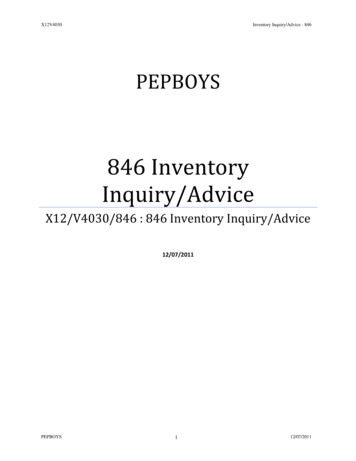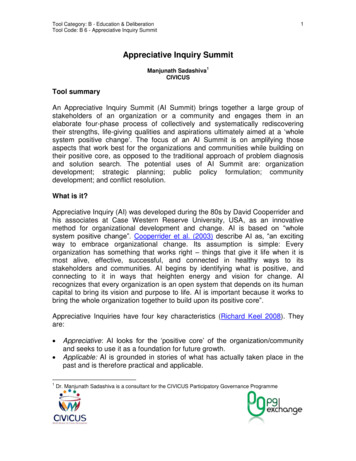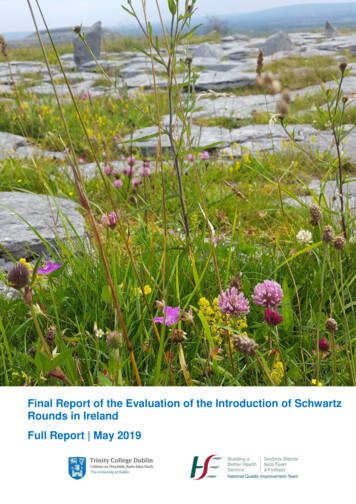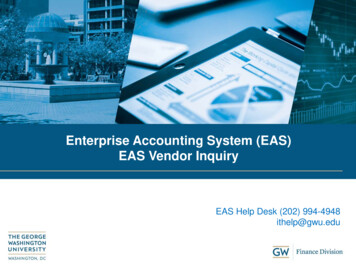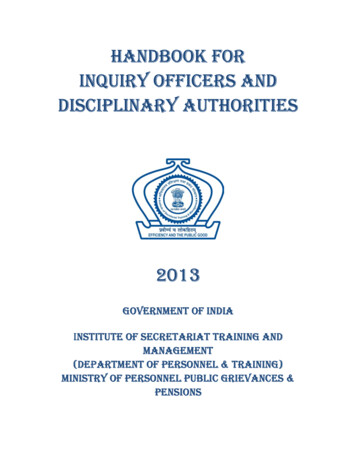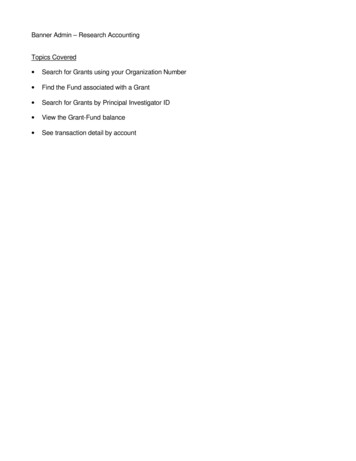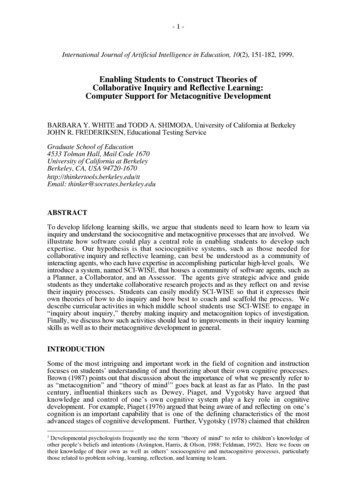![[Response To Inquiry Regarding Stoddard Solvent Pce Content] - Us Epa](/img/59/868545.jpg)
Transcription
1 .i Your Questions Re: Stoddard Solvent and PCEt .Jessica Ferrell o James CostelloHistory:02/27/2009 07:23 PMThis message has been replied to and forwarded.Jim:In response to your voicemail and emails from yesterday (attached for your reference):1) Yes, the P-D-680 series of specifications governs two types of solvent Stoddard and 140 F. Between1999 and 2006, it governed four types of solvent. Some maintenance manuals for equipment maintainedat the Solano facility (M42s, vehicles, and other weapons and machinery) call for the use of P-D-680 TypeII (140 F). Other manuals and orders require the use of "dry cleaning solvent," without reference toP-D-680 or a type: The versions of P-D-680 that contained PCE are MIL-PRF-680, MIL-PRF-680A, andMIL-PRF-680B. I have attached the cover sheet and relevant pages of those specifications here, with therelevant portions highlighted. The transcripts of our interviews of former Guard officers CasimiroGonzales and Antonio Marta contain statements that they each used dry cleaning solvent at the Solano .facility, and that they disposed of that solvent directly onto the ground.2) With respect to flash points, those are identified on the specifications that I sent you on CD on February10, 2009. Details are also provided in the last paragraph of this email and on the attached index.3) We do not yet know whether Stoddard solvent was used at the Solano facility or if it contains PCE.However, I have attached an excerpt of an MSDS indicating that it does contain a small percentage ofPCE.I have also attached the index of the specifications that I sent you earlier this month. It includesexplanations of the series of specifications that governed during different time periods. It also providesexplanations of how the specifications interrelate. We are missing some specifications, but haverequested those from EPA Regions 7 and 9 and expect to receive them in March 2009. I will send thoseto you upon receipt. Here is an excerpt from the index that responds to some of your questions onP-D-680;The P-D-680 series of specifications were incorporated by M42 operation and maintenance manuals thatrequired the use of dry cleaning solvent or minerals spirits paint thinner for various tasks.According to every M42 manual that we have located, all M42 components required cleaning with drycleaning solvent or mineral spirits paint thinner. The former National Guard personnel who the City andCounty have interviewed recall using dry cleaning solvent for this purpose. Some specifications call forthe use of the P-D-680 series of dry cleaning solvent. Other specifications do not. These specificationscould have instead required, for example, the use of 0-T-236C or its precursors, governing drycleaninggrade tetrachloroethylene. We are continuing to research this question.As specifications became more sophisticated, they contained more information and detail. For example,the first table in at least three later versions of P-D-680, MIL-PRF-680 (December 13, 1999),MIL-PRF-680A (July 25, 2003), and MIL-PRF-680B (Oct. 26, 2006), provide for tetrachloroethylene as aconstituent of each type of solvent governed by the various specifications. Allowable constituents werenot listed on relevant specifications issued before the late 1980s (such as P-D-680).According to the specifications that we have located for this substance, the physical and chemicalproperties of "dry cleaning solvent" governed by the P-D-680 series remained largely the same over theyears. For example, the initial boiling point set forth in all available specifications (issued in 1963, 1988,1999, 2003, and 2006) is 149 degrees Celsius for type I, and 177 degrees Celsius for type II. The dry pointr868545011379
is between 208 and 210 degrees Celsius for type I, and between 211 and 212.7 degrees Celsius for typeII. Similarly, the flash point for the P-D-680 substance, as constituted between 1963 and 2006, wasbetween 38 and 60 for type I, and between 60 and 92 for type II.Please let me know if you have any questions. Thanks.Jessica Ferrell Marten Law Group PLLC1191 Second Avenue Suite 2200 Seattle, Washington 98101206.292.2636 (Direct) 206.292.2600 (Main) 206.292.2601 (Fax)iferreii@marteniaw.com www.martenlaw.comThis e-mail may contain confidential and privileged information and is sent for the sole use of the iritendedrecipient.If you are not the intended recipient, please contact the sender by reply e-mail and destroy all copies ofthe original message.Please consider the environment before printing this e-mail.Message from Costello.James@epamail.epa,gov on Thu, 26 Feb 2009 17:03:32 -0800"Jessica Ferrell"* jferrelI( martenlaw.com 'Dry C leaner S afetyhttp://www.scif com/safetv/safetymeeting/Article.asp?ArticleID 471evidently perc has a higher flash point (i.e., less flammable) thanStoddard. Didn't you say you had info on flash points? — Message from Costello.James@epamail.epa.gov on Thu, 26 Feb 2009 16:59:04 -0800To: "Jessica Ferrell" jferrell( martenlaw.com Subject Mil Spec for PD 680 (Stoddard Solvent) 1963.pdf- Adobe: Reader(See attached file; Mil Spec for PD 680 (Stoddard Solvent) 1963.pdf)Looks like 680 could be one of two solvents. If it is Stoddard solventit may not be perc according to the other email I sent to you. Mil Spec for PD 680 (Stoddard Solvent) 1%3.pdf— Message from Costelio.James@epamaii.epa.gov on Thu, 26 Feb 2009 16:56:47 -0800011380
To: "Jessica Ferrell" jferreU@martenlaw.com Subject NIOSH Worker Notification Program - Dry Cleaners:(1)http ://www. cdc. go v/n iosh/pgms/worknotifv/Drycleaner 1 .htmlThis seems to say stoddard solution is not perc (see my other email)Index - Docs to EPAre. National Guard 2.10.03 from JKF (00180632-2).PDFi'' iit«SSafety-Kleen 105 Solvent Recycled MSDS 11-27-02 (001S204S).PDFMIL-PRF-680B Perfomiance Specification Degreasing Solvent fO0182O52).PDFMlL-PRF-880 Perfoimance Specficstion Degreasing Solvent (001820M).PDFMIL-PRF-G80A Degreasing solvent properties {O0182O51).PDF011381
P-D-680ttUrOt 37. IMIBUPEBSmiNGJnne IS, 1961 u dFad. Spec P-S.66]bApril «. 19SSFEDERAL SPECIFICATIONDRY CLEANING SOLVENTTkit aptcifieatiirn WM apprwvi by tk» Committitmer, Federal Supply S«rviu, OttneraX Scrvie«i Adminittration, for the u*f of all Federal agmeitt.1. SCOPE AND CLASSIFICATION1.1 Scope. This npecification covers twotypes of petroleuin distillates employed fordry cleaning of textile materials, and referred to induBtrially as "Stoddard Solvent"and as "140" F. Solvent".1.2Classification.1.2.1 Typea. Dry-deaning solvent aha]]be oi U«c tciilonijig typca, as specified:Type I. 100'F. Solvent (Stoddard Solvent) .Type H,—IW'F. Solvent.2. APPLICABLESPECIFICATIONS,STANDARDS, AND OTHER PUBLICATIONS2.1 Specification-s and Standards. Thefollowing specifications and standards, ofthe issues in effect on date of invitation forbids, form a part of this specification:Federal Standards:Fed. Std. No. 102—Preservation, Packaging, and Packing Levels.Fed. Std. No. 123— Marking for Domeatic Shipment (Civilian Agencies).Fed. Teat Method Std. No, 791—Lub.rjcants, Liquid Fuels, and RelatedPiodncta; Methods of Testing.(Activities outside the Federal CovemiDeat mayobtain eople« ot Tedera) SpecUicatlona, Standards,and PandtMoks as outlined under General Infonna.tion in the Index of Kcdera] Sppcifieations, Standorda, and Ilaodbonka and at the prices indicated Inthe Index. The Index, which include* coninlAtivemonthly (uptilenienta as isaued, is for sale on a «ubscription basis by the Superintendent of Documents,U. S. Guvemment Printing Oaiee, Washington 2fi,D. C(Single copies ot this speclficatian and otherproduct speci{ication» required by ftctivitiea ootsidethe Federal Covcrnment for bidding purposet areavaiilable without oharge at the General ServicesAdministration Regional Officea in Boston, tievYork, Washington, D. C, Atlanta, Chicago, KansasCity, Mo., Dallas, Oetivet:, San Francisco, andAuburn, Wash.(Federal Covcmmtni acUvities may obtain copiesof Federal Specifications, SlAndards, and Handbooks und the Index of Fedcrsl SpcclfieatJoiis,StandarilB, and Handbooks from establlahed dia*triboUon points in their agencies.)Military Standards:MlL-STD-105—SamplingProceduresand Tables for Inspection by Attributes.MlL-STD-129—Marking for Shipmentand Storage.MIL.STD:290—PeckaginK, Packing andMarking of Petroleum and RelatedProducts.(Copies n.' Military Specificationa and Standardsrequired by controctoru in connection with speeineprocuresncnc funcHuns should be obtained from theprocurinc aeti%ity or as dtreetitd by the contractingofficer.)FSC 6850011382
P-D-6802.2 Other publicationB. The followingpublications form a part of this specification.Unless otherwise indicated, the issues in effect on date of invitation for bids shall apply:American Society for Testing and Materiaie Publication:Part 7 -Pctroleum Products and Lubricants.(Copies tn:iy he obtained from the American Solipty for Trsiing and Materials, 1916 Race Street,Philadelphia 3, Pennsylvania.)TABLEI. Phyaieai and ekemical prppertisaTeatPan.Clear, free from sus* 1 4.4.2pended matter, andundissolved watar !Typol 1AppearanceTTfon 1Color, Saybolt, not greater than . . . 2121OdorSweetSweetCorrosion of copper strip 212» F. SUgbt{or 8 honrstarnish' 'Distillation range:Initial boiling pt.,min300' F.360* F.5C% disliHed byvol., min. . . . . . . 3 5 0 ' P .876* F.End point, max. . i430' P.416" F.DistdUatJon real.due, max1.5%!.»%Acidity-reaction ofresidne to methylorangeNeutralNeutralDoctor testNegative NegativePlash Point. Tagrinecd Cup, min. j100 P.138" P. 1Sulfone Bcdd absorption, max. .1{6%4.44 Uniform ClaaBifieatiun Committee Publication :Uniform Freight Claasifiration Rules.(Applicxiticiii for copies thould be addresfcd toUnilonn ClasaificatJoo Committee, 202 Union Station, Ohiea 6, Illinois.)3. REQUIREMENTS5.1 M«li nfll. The mnterial shall be «petroleum distillate.3.2 Physical and chemical propertice. Thephysical and chemical properties of the solvents shall conform to the requirements specified in table I.3.3 Workmanship. The dr - cleaning solvent shall be clear, fret froni suspended matter and undissolved water as determined byvisual inspection.4. SAMPLING, INSPECTION.TEST P R ( X ; E D U B E SAND4.1 The supplier is responsible for theperformance of all inspection requirementsas specified herein. Except as otherwisespecified, the RUppii«r may utilize his ownor any other inspection facilities and scrV'ices acceptable tc the Government. Inspection record of tht exuminationB and tealsi hali be kept complete and available to theCJovernment as specified in the contract or011383u*4.4.44.4.fi4.4.14.4.14.4.1' SM) corresjwnd to claasirieation number 1 olASTU designation D ISO.order. The Government reserves the rightto perform any of the inspections set forthin the specification where such inspectionsare deemed necessary to assure that suppliesand sen-ices conform to prescribed require ments.4.2 Sampling.4.Z.1 Lot. For purposes of samiding, alot shall conaist of solvents from one batchor tank offered for delivery at one time. Ifmaterial cannot be identified by batdb ortank, a lot s.haU consist of not more than10,000 gallons offered for delivery at onetime.4J.2 Sampling for inspection of contain"era. A random sample of filled containersshall be taken by the Government iTtspectorin accordance with Military Standard MIL-
P-D-680STD-105 at inspection level I and acceptablequality levd — 2.5 percent defective to verifycompliance with this specification in regardto flll, closure, marking, and other requirements not involving tests.4.2.3 SampiiTio for teste. From each inspectjon lot (see 42.1), the inspector shalltake two containers at random. F m eachof the two containers l ijuart specimens shallbe taken and placed in separate, clean, dry,metal, or glass containers, and then sealed,marked, and forwarded to the testing laboratory designated by ihe procuring activity.4.3 Inspection of containers. Each sample filled container shall be examined for defects of construction of the container andthe closure, for evidence of leakage, and forunsatisfactory markings; each filled container shall be weighed to determine theamount of contents. Any container in thesample having one or more defects, or underrequired fil!, iihall be rejected and if thenumber of defective containers in any sample exceeds the acceptance number for theappropriate sampling plan of MIIrSTD-105,the lot represented by the sample shall berejected.4.4 Test procedures4.4.1 Phjfrieai and ehemieal properties.These determinations shall be made in accordance with the methods specified in tablen.4.4.2 Appearance. 'Examine the solventfor undissolved water, sediment and suspended matter by the use of transmittedlightOdor. If the odor is questionablethe following test shall be performed. De*sized and laundered bleached cotton dothof 3.6 to 4-0 ounces per square yard aballbe used for this test. The doth when lightlysteamed ahall have no odor except that ofclean cotton doth. The cloth shall be conditioned at 50 to 80 percent R.H. and 65 TABLEII. Test proceduresApplicablemethod inFed. TeatMethod SULNo. eanne*Table!—'Color101.6Table ITable 14.4.3OdorTable 1Copper Corrosion . &325.2DistiUsXianTable 1DdstUUtion range 1001.9DistilUUon residue4.4.4Table 1Table 1Acidity4.4 STable Idoctor teat5203.2Flash pointTabic I1101.5—HuUaric Acid Ab(See Note)sorption—Vote: Determine according to ASTM D4S4-Ji2.to 90'F. for 4 hours. A piece of the conditioned doih approximatdy 12 inches squareshall be placed in 100 milliliters of solventso as to W cumpleldy submerged, and allowed to soak for 5 minutes. The doth shallthen be removed, druned, but not squeezedor extracted and hung at room temperaturefor 2 hours. The doth shall then be dried iha stream of fresh air heated to 140 to 160 P. (60 to Tl-C.) for 1 hour. The odor ofthe dried doth when steamed over boilingwater for 4 to 5 seconds, shall not differfrom that of an untreated sample similarlysteamed.4.4.4 Distillation residue. Four the distillation re due from the flask into a smallcylinder graduated to O.I milliliter. Cool,measure and record the volume as residue.4.4.5 Acidity. Make this test immediatelyafter recording the volume of distillationresidue. Transfer the cooled residue to a testtube, sdd three volumes of distilled water,and shake the tube thoroughly. Allow themixture to separate and remove the aqueouslayer to a dean test tube by means of a pipette. Add I drop of 0.1 percent aqueous solution of methyl orange. A pink or red colorindicates the presence of mineral acid.3011384
P-I - 805. PREPARATION FOR DELIVERYFor uvil &seaey procurement, the deftni- tions and applications of the levda of pMJCkaging and packmg shall be in aeoordaneewith Fed. Std. No. 102.5.1 Packaging and packing.5.1.1 Levels A and B. The sotwit shallbe packaged and packed in aooordanoe withMIL-STD-290 as spedfied for Ote amdhaOdelevd (see 6.2).5.1.2 Level C. Commercial anh and baOccontainers shall be packed so as to be aooeptable by common or other carrien for safetransportation to point of destination spedfied in shipping instruction at the lowesttnniBportation rate.5.2 Marking.5.2.1 Ciinl ageneies. In addition tn anyspecial Tt\artiu& fequirvd by tiw oonizact ororder, marking for shipmcat diall be in accordance wit Fed. Std. No. US.(a)Title, number and date of this speciflestkm.(b)Type of solveot required (see 1.2).(e)Sise of eontalneta and Isvel of protection tequlred (see 5.1 and 5 J ) .6 Parehase mdt. The advent shall bepnrehaaed by vdume, the imit being a U.S. o n Of 231 cubic inches at 60 F. (19.6 C.).liie vdome may be determined by dividingthe net weight, to poonda, by the weightpar ailkia.%A TnawQQrtatlan description. Transpertatiim deseriptiana and minimum wdghtsappJieaUe to this commodity are;Rafl:(ihemieals, not otherwise indexed byOaiload minimum w d t 24«000pouads, sabjaei io Rule 94, liniform F r d t Claadfieatton.Uatat".5.2.2 Afttitory off&neiss. In addttftm toany special maridog required hy tiw eontract or order, maridng for sMiBBent shallbe in accordance with HIL-STD-129.6. NOTES6.1 Inienotid use. The product is intended for use as a dry-deaninar solvent.6.1.1 Type I is intended for use as a comparatively safe dry-deaniog solvent.fi.1.2 Type II ia intended tor nae is drydesning plants where a solvent with ahigher flash-point is desirable as an additional safety factor.6-2 Ordering data. Procnivment docoments should spedfy the foDowtng:011385Cbemleals, not otherwise indexed.Trackloed mininram weight 24.000pounds, sabjeet to BQI« 115, Nattonal Motor Freight Chuwlfiea6.6 Ccftifleaiifoii. Solvent delivered incans, dmms, or task ears shall dtber beaccompanied by an ofifieial goer's certificate showing tiie net contents of each eonta&jer and also the temperature of the contents at the time of gaging or shall be subject' to gaging by the Government inspector.In file aheence of a statement of the tempAraton at the time of gaging on the offidal'gaffer's eertifieate, or in case the bairdsAam evidence a! loss by leakage or otherBhortaftea, tihe ddlvery shall, be subject to
P-D-680re-inspection and re-gaging by the Government inspector.Noticeu WIMO Qovanuoent dnwingt, tpodfieationa, «r othor data * M uaad for any pnrpoaa ath«rtluui in conneetlon with a definltaly T«la4«d OawntQwnt pnxnnBMBt apwatioo, tha UsUad 8tates Qoreminent thereby incora no reaponsfbUitr, nor anyobllgftticn whatMVwr; aa4 tha fact that tha Ga ««itiment may have formolatad, fnnlshed, or in any wsyvoppUod the i&ld drawinK»i ipcctncatloBS, or otherdata, is not to be regarded by Implication at otborwiu, aa In any manner Ueanalng th« hbSdor or anyottar person or cwporatfanb or oonvoyisg any tightsat pemiadon to mamlactutt, QM. «t tidl asypattatad tnvmtJoD tiiat may In any way be ralatadttuftveto.MILITARY INTERESTS:Army -HU MR GLNavy—ShAir Force—MAAMACopies of this spedficatiion may be parchaard for i cents «ach.011386
INSTf UCTIONS: In s continuing effort to make our standardisation documtnu better, the DoD prorldei thiM torn for use insubmitting camments and suggoctions for bitprorements. AU usei* of military staadardixatton document* a n iiiTitad lo provideeuggesUona. This (OTO nay be dmaehed, folded alooc the line* indicated, taped along the loose edge ( 0 0 NOT STABLE), andmailed. In block 6, be as spacific as pcailble about particular problem areas nidi u wording which icqulrad lsterpf«tation, WMloo rigid, restrictrvc, loose, ambiguous, or wat incompatible, and give propoaed wordinf changet which would ali«*i«t« theproblems. Enter in block 0 any lamarks not related to « spcciric paragraph of the document. It block 7 is filled out, tnoeknowladfcmenl will be mallod to you within 30 days to l«t you know that your commmttt weie reccifed and are beioffconsidsTod.NOTE; Tbi* form may not be used to requcet copies of di cumenU, nor to request waivers, deriatiooa, or clarincatkon ofipecltlcstioB requirementa on current contracts. Comments submitted on thii form do not eonsUtut* or imply tuthorttstionto waive any portion of the referenced document i or to amend contractual requirements. Po(d along tfU lltfi 'Fold tloni rib lint)OEPARTMECn- OF THE ARMYOFFICIAL SUSINEISPENALTY FOA FAlVATE USE 300nilBUSINESS REPLY MAILFtnsT C L A S SP E R M I T KO. t j o e ivw«SHipariTON o. cPOSTACe WICL BE PAID BY THE DEPARTMENT OF THE ARMVCommanding Officerl/S Array Munitions CommandAttn; SMUFA-5500P h l l a . , PA 19137011387MlNO rOSTAOENECESSARi r MAItEOINTMtUM)Tet STATES
STANDARdfZATION DOCUMENT IMPROVEMENT PROPOSAL(See iHstruetiota - Rnerx def1. DOCUMENT NUMSEHa. OOCUMCNT T i T L t » N A M ( OF SUBMITTINO OROANIZATIONa. T V P t OF OnOANIZATlON ( M « * om*lr VtMOOSk. AO j n E B » (Srra«c. Clt . S u m . S i r CoMtj)MANUFACTUSEFIS.PROSLEM AREAS& P*r*9r«0«i Nvmbor uiO WortflAf .-U) Ii'a. R««omfn*n««0 WerOInf:o'uIi\iiP.c. nM*on/niitw kta I m n«cDmin«n iatton'.5lQ ia. REMARKS7a. NAME OF SUBMITTER f l o t t . f l n t . Ml) - Dmlena)». WORK TELEFHONE NUMBER Iltulti4» A mCo4»l - OotloMie. M A I t I N C AOOReCS r8tt*« . C(rr. SlaO, CIF C o t OpKenal«. DATE OF SUBMISSION tYYMMDb)DD /A"rR 1426011388FRCVIOUS EDITION IS Q O L E T e .
IndexDocuments Sent to Jim Costello (EPA Senior Attorney)and Cynthia Brown (EPA Removal Enforcement Coordinator), February 2009Re: New Mexico National Guard Liability at Walnut and Griggs Ground Water Plume{00180218.DOC/3}011389
scription of interview conducted by EdFridenstine (Dona Ana County) of formerNational Guardsman Casimiro GonzalesMr, Gonzales was stationed at Solanoand Hadley Armory (the "Solanoarmory") in Las Cruces, Mobilization andTraining Equipment Site, from 1965-68and 1971-73.-Former positions/ranks: maintenancemechanic, ordnance branch, NationalGuard State Organizational MaintenanceOfficer, Captain, Lieutenant Colonel.Primary RelevanceMr. Gonzales reports the use of dry cleaning solvent for M42maintenance at the armory. See Transcript ("TR") page 8.Reports use of dry cleaning solvent in wash racks at Solano armory inone and possible five and 55-gallon drums. TR pp. 8-11.Reports use of dry cleaning solvent by mechanics in vats insidearmory maintenance bays, and disposal of solvents into sumps. TRpp.8, 11.Reports use of dry cleaning solvent on gun barrels and sprayingengines and tracks down with dry cleaning solvent throughair-compressed spray guns. Solvent was sprayed onto equipment onthe outdoor steam rack next to armory. Solvents drained ontoconcrete and into a sump. From there, solvents drained to theground or, potentially, the sewage system. (Mr. Gonzales was notcertain whether the sump was connected to the sewer or not.) TR pp.6-8, 10.Reports operating according to the Department of the Army TM9-2910-213-34&P, Direct Support and General Support MaintenanceManual for pump. Fuel, Engine, Assembly (December 1985), whichrequired the use of dry cleaning solvent P-D-680, Type II (81348).TR page 9. (See pages 3-2 and C-1 of TM 9-2910-213-34&P)Confirmed use of dry cleaning solvent, per operator's manual portionof Department of the Army Technical Manual ("TM") 9-7218, Twin40-MM Full Tracked Self-Propelled Gun M42 (T141). TR p. 5.{00180218.DOC/3}011390
Military and Federal Specifications.P-D-680 Series Governing Dry Cleaning SolventThe P-D-680 series of specifications were incorporated by M42 operation and maintenance manuals (also listed below) that requiredthe use of dry cleaning solvent or minerals spirits paint thinner,for various tasks.According to every M42 manual that we have located, all M42 components required cleaning with dry cleaning solvent or mineralspirits paint thinner. The former National Guard personnel who the City and County have interviewed recall using dry cleaning solventfor this purpose. Some specifications call for the use of the P-D-680 series of dry cleaning solvent. Other specifications do not.These specifications could have instead required, for example, the use of 0-T-236C or its precursors, governing drycleaning gradetetrachloroethylene. (The earliest version of O-T-236 that we have found so far, issued on August 6,1979, is provided as an examplein the "1970s specifications" folder). We are continuing to research this question.As specifications became more sophisticated, they contained more information and detail. For example, the first table inMIL-PRF-680 (December 13, 1999), MIL-PRF-680A (July 25, 2003), and MIL-PRF-680B (Oct. 26, 2006), provides fortetrachloroethylene as a constituent of each type of solvent governed by the various specifications. Allowable constituents were notlisted on relevant specifications issued before the late 1980s.According to the specifications that we have located for this substance, the physical and chemical properties of "dry cleaning solvent"governed by the P-D-680 series remained largely the same over the years. For example, the initial boiling point set forth in allavailable specifications (issued in 1963, 1988, 1999, 2003, and 2006) is 149 degrees Celsius for type I, and 177 degrees Celsius fortype II. The dry point is between 208 and 210 degrees Celsius for type I, and between 211 and 212.7 degrees Celsius for type II.Similarly, the flash point for the P-D-680 substance, as constituted between 1963 and 2006, was between 38 and 60 for type I, and ,between 60 and 92 for type II.DateMarch 27,1963{00180218.DOC/3}011391DocumentPrimary RelevanceFederal Specification P-D-680, Dry CleaningSolvent (superseding Int. Fed. Spec. P-S-99661c(GSA-PSS) June 1, 1962 and Fed. Spec.P-S-661b (April 6, 1958)Governs two types of petroleum distillates employed for drycleaning of textile materials, referred to industrially as "StoddardSolvent" and "140 degree Solvent."
September9, 1988Federal Specification P-D-680A, Dry Cleaningand Degreasing Solvent (superseding FederalSpecification P-D-680, Dry Cleaning Solvent(March 27, 1963))Governs regular (Stoddard solvent, type I) and high flash point(type 11), used for dry cleaning, spot and stain removing, anddegreasing of machine parts in equipment maintenance.Allowable constituents include toluene, ethylbenzene, solvent witholefinic or cycloolefinic unsaturation, aromatic compounds, andbranched chain ketones. See page 4.December13, 1999Performance Specification MIL-PRF-680,Degreasing Solvent (superseding P-D-680B (Oct.29, 1992)Governs degreasing solvents types l-IV: Type I (low flash pointStoddard solvent); Type II (high flash point); Type III (very highflash point, 200 degrees F); and Type IV (high flash point withcitrus odor). All are for degreasing of machine parts in equipmentmaintenance.All four provide for up to 0.5 mg/L of tetrachloroethylene as achemical constituent. See pages 1,5-6July 25,2003Performance Specification MIL-PRF-680A,Degreasing Solvent (superseding MIL-PRF-680(December 13, 1999)Governs degreasing solvents types l-IV: Type I (low flash pointStoddard solvent); Type II (high flash point); Type 111 (very highflash point, 200 degrees F); and Type IV (high flash point withcitrus odor). All are for degreasing of machine parts in equipmentmaintenance. All four also provide for up to 0.7 mg/L oftetrachloroethylene as a chemical constituent. See pagesi; 5-6,tbi. I; 7, tbi. II.Oct. 26,2006Performance Specification MIL-PRF-680B,Degreasing Solvent (superseding MIL-PRF-680A,Dec. 25, 2003) (superseding MIL-PRF-680A,December 25, 2003)Governs degreasing solvents types l-IV: Type I (low flash pointStoddard solvent); Type 11 (high flash point); Type III (very highflash point, 200 degrees F); and Type IV (high flash point withcitrus odor). All are for degreasing of machine parts.Also provides for up to 0.7 mg/L of tetrachloroethylene as achemical constituent of types l-IV of solvent. See page 5, tbi. 1and page 7, tbi. II.{00180218.DOC/3)011392
1950s SpecificationsDateDocurnentPrimary RelevanceMay 1952Department of the Army Technical Manual 9-252,40-MM Automatic Gun M l 40-MM, AntiaircraftGun Carriage M2A1 and 40-MM Gun Mount M3Requires use of dry cleaning solvent or volatile mineral spritspaint thinner for cleaning, care, and other maintenance of M42s.See Chapter 9.May 1957Department of the Army Technical Manual 9-7218,Twin 40-MM Full Tracked Self-Propelled Gun M42(T141), including Lubrication Order ("LO") 9-7218,Gun, Self-Propelled, Full Tracked: Twin 40-mm,M42 and M42A1 (March 30, 1954) {excerpt).Requires use of dry cleaning solvent or mineral spirits paintthinner for various maintenance functions.June 10,1957Department of the Army Technical Bulletin9-7218-1, Twin 40-MM Full Tracked Self-PropelledGun M42A1: Operation and OrganizationalMaintenance Instructions for Peculiar Items(excerpt)Requires use of dry cleaning solvent or mineral spirits paintthinner for cleaning and inspection of fllter element and drivescreen vent. See pages 14, 47. During disassembly, requiresuse of dry cleaning solvent or mineral spirits paint thinner forcleaning and inspection of "all parts" on M42s. See pages 42,440.{00180218.DOC/3)011393
1960s SpecificationsDateApril 5, 1966DocumentPrimary RelevanceMilitary Specification M]L-G-45178A(MD) Gun,Self-Propelled, Full Tracked: Twin 40MM, M42and M42A1; Preparation For Storage andShipment Of.Requires use of, among many other chemicals, MIL-C-16173("Corrosion Preventive Compound, Solvent Cutback, ColdApplication"), which, in turn, required the use of dry cleaningsolvent conforming to P-D-680.*This specification calls for the use of various other substancescontaining unknown chemicals. See pages 1-2. We haverequested several of the specifications governing thosesubstances from, among other entities, the National GuardBureau, Department of the Army, Army Publishing Directorate,and National Archives and Records Administration under FOIA,and from the New Mexico Department of Military Affairs underthe New Mexico Public Records Act We have yet to receivethem, so do not yet know whether they contained PCE.October 20,1966June 7, 1968{00180218.DOC/3}011394Military Specification MlL-C-16173, CorrosionPreventive Compound, Solvent Cutback,Cold-ApplicationMandated for use in preparation of M42s for storage andshipment by Military Specification MIL-G-45178A(MD) (April 5,1966). Required use of a "dry cleaning solvent conforming totype 1 of P-D-680" for removability determination. See pages 1,10 (section 4.6.7).US Army Lubrication Order ("LO") 9-2350-202-12,Gun, Antiaircraft, Artillery, Self-Propelled: Twin40MM, M42 and M42A1 (excerpt)Requires use of dry cleaning solvent or mineral spirits paintthinner for parts cleaning on M42s. See page 1.
1970s SpecificationsDocumentPrimary RelevanceFebruary 24,1975Military Specification MIL-C-16555D, CoatingCompound, Strippable, Sprayable.Mandated for use in preparation of M42s for storage andshipment by Military Specification MIL-G-45178A(MD).Provided for use of volatile solvents and other hazardoussubstances detected at the Griggs and
However, I have attached an excerpt of an MSDS indicating that it does contain a small percentage of PCE. I have also attached the index of the specifications that I sent you earlier this month. It includes . MIL-PRF-680 (December 13, 1999), MIL-PRF-680A (July 25, 2003), and MIL-PRF-680B (Oct. 26, 2006), provide for tetrachloroethylene as a .
